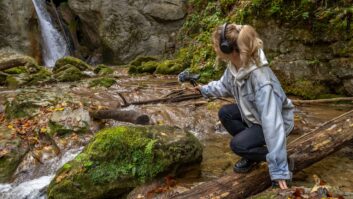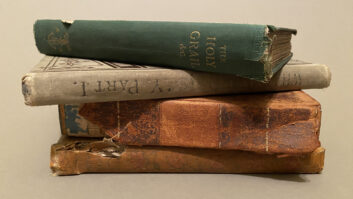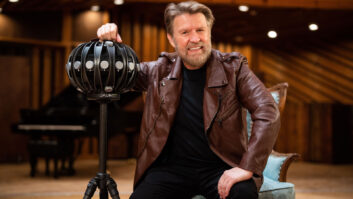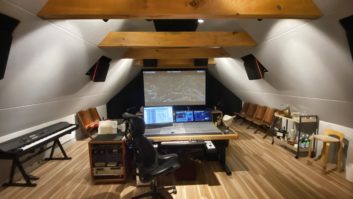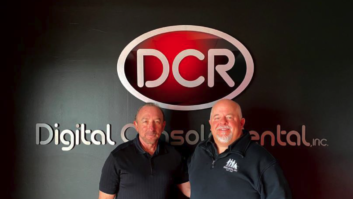From April 23 to 26, some 112,000 production pros packed intoLas Vegas for the National Association of Broadcasters convention.Even with four days, you’ll barely see even half of the 1,700exhibitors — assuming three minutes at each booth and nostops for breaks, meals, taxi/shuttle bus lines or long jauntsbetween distant halls. There should be a whole lot of walkin’ goingon in 2002, when the Las Vegas Convention Center opens its918,000-square-foot South Hall, nearly doubling the capacity of thepresent LVCC. Perhaps that’s why NAB chose “Embrace theFuture” as the theme for NAB 2001; the most popular item atnext year’s show might be jetpacks to whisk visitors from hall tohall — a real opportunity for some Vegas entrepreneur.
But we digress. Product debuts tend to run in cycles. Last year,the emphasis was on rackmount 24-track recorders, mics and signalprocessing — both hardware and plug-in varieties. This year,the push was on new consoles and workstation developments. Here area few items that caught our attention.
CONSOLES: BIG NEWS!
Munich-based Klotz Digital AG, announced that its U.S.subsidiary, Klotz Digital America Inc. (www.klotzdigital.com), acquired Californiacompany Graham-Patten Systems (www.grahampatten.com), the manufacturer of theEmmy Award-winning D/ESAM™ digital editsuite audio mixers. The acquisition gives Klotz an edge in thebroadcast/post-production market, and adds manufacturing capacityfor Klotz products. One of the company’s key goals is to get themuch-anticipated D/ESAM 8000 flagship digital board to market byQ4, 2001.
Klotz showed a number of digital on-air consoles. The Paradigm16 radio mixer offers voice processing on all mic inputs, SRCs onall digital line inputs, machine control, 12 faders with A/Bswitching, four faders with analog/digital six-source selectors andconfigurations that can be saved for each operator. Klotz’sSpherion console comes in 12-fader (24-input sources) and 20-fader(40 source) versions. Sources can appear on any fader, with machinecontrol logic following each source. The 20-fader Spherion includesEQ, limiters, gates and compressors, and a fiber-optic network canlink multiple units throughout a facility. Klotz’s new VADIS 880platform expands the power of its VADIS systems, adding networking,24-bit mic preamps, format conversion, etc., as well as Ethernetand MADI options for its VADIS D.C. II mixers.
SSL (www.solid-state-logic.com) added a“plus” to its console line, showing new, expandedmodels including the Aysis Air Plus broadcast production board, theAvant Plus post/film mixer and the MT Plus music productionconsole. All “Plus” designations feature INFO faders,TFT LCD display and SSL’s HS control processor. The latter offers apowerful (and intuitive) high-speed operating environment (said tobe 10 times faster), and adds enhanced features.
The big news at SSL was the unveiling of the MT Production (MTP)digital mixer. Based on the company’s latest MT Plus in-linedigital console, MTP features snapshot reset, flexible subgroupbusing and multiformat surround sound capabilities, but in acompact package for multitrack TV, remote truck andmusic/entertainment applications. Sharing the MT Series’ analogconsole-style ergonomics, the MTP has one-knob-per-function design,along with the HS control processor, an in-line mixing architectureand simultaneous 5.1 surround sound outs. In TV productionapplications, MTP offers clean feed buses, mix-minus outs andmultitrack backup capability. Its analog side was designed toexceed the performance of SSL’s SL 9000 J Series console.
Soundtracs (distributed in the States by Fairlight,www.fairlightesp.com.au)launched the D4, a major, new large-format digital consoleavailable in configurations from 16 to 96 moving fader channelswith up to 320 inputs assignable to 128 output buses. It supportsstereo/LCRS/5.1/7.1 surround formats at 48 kHz or 96 kHz. Havingevolved from the company’s successful DPC-II and DS-3 mixers (withmore than 400 in use worldwide), the 24-bit D4 is based on thatsame intuitive, touch-sensitive control surface, with powerfulonboard DSP, full networking capability and support of all digitalformats, including AES/EBU, TDIF, ADAT and MADI. Eight consoleshave already been sold.
Amek (www.amek.com) had two major unveilings at NAB.The 60-channel Media 51 is a new, large-frame version of themid-price multiformat analog console Amek debuted a year ago at AESParis. Media 51 is equipped to handle 5.1, 7.1, LCRS, LCRSS andstereo formats, and features Supertrue V4 automation, VirtualDynamics™, Recall, VisualFX™, full surround monitoringfacilities, encode/decode processor insertion, downmixing/stemmonitoring capabilities and PEC/direct switching. An optionalmotorized joystick panel offers multiple panning modes up to eightchannels wide with four switchable divergence settings, and an“expand” feature provides HF image enhancement.
Amek’s new Galileo 360V multiformat console offers comprehensivemixing/monitoring facilities for surround formats up to eightchannels wide, with a high degree of connectivity and control.Galileo 360V features a microphone amplifier designed by Mr. RupertNeve, plus the proven musicality of the Amek 4-band fullyparametric equalizer.
Long regarded for its live consoles, Midas (www.midasconsoles.com) showed theB2000, the first in a line of analog broadcast mixers. The B2000supports mono, stereo, LCRS, and 5.1 or 7.1 surround. AES/EBU I/Oconverters are optional, as is an A/V router interface and snapshotautomation. The B2000 is available in 24- to 72-channel frame sizes(both mono and stereo input modules are offered), and otherfeatures include a limiter per input; the popular Midas EQ; six auxbuses (talent monitors); eight mix-minus buses for news talentfeeds; eight stereo subgroups (six become 5.1 master outputs inSurround mode); and dual-power supplies.
Euphonix (www.euphonix.com) — no stranger tobroadcast desks with its analog consoles — unveiled theSystem 5-B, an on-air version of its award-winning System 5 digitalmixer. The 24/96-capable System 5-B features amenities such asMulti-Format Channels (where a single channel strip can controlstereo/LCR/LCRS/5.1/7.1 signals), stereo channel with integral M-Smic decoding, integrated 672×672 I/O router, on-screendiagnostics, optional PEC/direct switching, dual motorizedjoysticks, and more. We liked the little touches, such asadjustable loudspeaker shelves, rolling script tray and producer’sdesk with large, 16:9-format TFT display for viewing picture orworkstation displays.
New features for the AMS Neve (www.ams-neve.com) Libra Live Series II digitalbroadcast mixers include a metering package that displays twolayers of inputs simultaneously; a second center-channel strip foreasier access to channel controls from either side of a large desk;and Version 2.7 software, which improves mix-minus control, expandsDolby E support and simplifies surround operations.
Harrison (www.harrisonconsoles.com) debuted its TVD on-airdigital television console, based around a compact control surfacethat can be remotely accessed from up to three locations via thecompany’s Satellite Touchscreen technology. A standard package has24 mic/line inputs, 18 stereo line inputs, 12 mix-minus feeds, 16aux sends and 5.1 capability both as inputs and outputs. All signalprocessing is 40-bit, courtesy of Harrison’s provendigital.engine™ technology, andstandard amenities include moving faders, snapshot automation and a2240×2240-capable routing system. Harrison also announced thatit was offering its award-winning LPC (Live Performance Console) ina fully digital version, based on the digital.engine and a compact40-fader control surface, connected via copper or fiber-optic linksfor up to 768 full channels.
Not all consoles at NAB were BIG. AETA Audio (www.aetausa.com) showed a compact(9.5×4.5×1.75-inch), 4-input analog ENG console withremarkable -130dB noise performance, optional AES/EBU interfacing,46dB input headroom, long battery life and switchable M-Smonitoring — all in a rugged aluminum case. Awesome!
DAW DEVELOPMENTS
SADiE (www.sadie.com) expanded its RADiA line with thePlatinum, a 4-in/4-out turnkey system, including rackmount 667MHzPentium III PC, 128MB RAM, 10GB internal drive, 15-inch LCD screen,breakout cables and removable 9GB SCSI drive. The system has ahardware controller with transport controls, scrub wheel,Edit/Locate/Function keys, motorized faders and time displays.SADiE also announced that it’s the first to market productssupporting the AES31 universal file-exchange format. Ratified as aninternational standard, AES31 is open — not exclusive to anysingle manufacturer — and supports multichannel files.
Mackie Designs (www.mackie.com) entered into an agreement withSoundscape Digital Technology, where Soundscape (www.soundscapedigital.com) willcontinue to distribute products developed by Sydec under theSoundscape brand name, such as the 32-track R.Ed. DAW and theMixpander PCI card. Sydec was acquired by Mackie on April 3,2001.
Previously an adjunct for its Postation II workstation, DSPMedia (www.dsp media.com)has packaged its popular VMotion integrated video system into astand-alone, disk-based video box, offering real-time networkingand instantaneous file location via a touchscreen interface.
Digidesign (www.digidesign.com) announced Pro Tools|24MIX3 (pronounced MIX-cubed), offering moreaudio processing power and support for 48 channels of I/O. The$11,995 retail system includes the MIX core and two MIX Farm cardsand the surround mix-capable Pro Tools 5.1.1 software, which nowsupports both Power Mac and Windows 2000.
Fairlight has added support for the huge range of VSTsoftware plug-ins with the announcement of its Plug-Ins Managersystem offering high-speed, low-latency operations via SystemServices Module DSP boards, with seamless integration with existingFAME2 and Prodigy 2 user interfaces and automation. Both real-timeand non-real-time VST plug-ins are supported.
WaveFrame (www.waveframe.com) debuted WaveFrame/7, thelatest generation of its flagship DAW. The new system retains thefamiliar WaveFrame editing interface, while adding 24-bit audioresolution, 5.1 mixing, DirectX DSP plug-in support, networking andup to 32 channels of I/O. The system records/plays standardbroadcast .WAV files and can import SD2, WaveFrame V6.x files andthe OpenTL files used by Tascam’s MX-2424 multitrack. Meanwhile,Version 4 software for the FrameWorks/DX system adds features suchas 24-channel AES/EBU support, 192kHz functionality and a DSD/SACDoption.
Speaking of SACD, Merging Technologies (www.merging.com) should ship itsPyramix DSD editor (developed jointly with Philips) this month.Features include 2 to 24 channels of DSD recording/editing,real-time FX and crossfades, and PCM-to-DSD conversion.
So after using all of these cool tools to create a masterpiece,how do we get it out to the world? Microsoft (www.microsoft.com) suggested a solutionin the form of Windows Media Audio and Video 8, offering real-timedelivery of full-screen, near-DVD-quality film content over today’sbroadband connections. The Windows Media Audio and Video 8 codecsare compatible with Windows Media Player 7 and 6.4, as well asWindows Media Player 7 for the Mac, released at NAB.
NAB returns to Las Vegas from April 6 to 11, 2002. Mark yourcalendars, and don’t forget those jetpacks!
Product Spotlight: Fostex DV40 Master Recorder
As more projects move toward high bit resolution and highsampling rates — particularly in HDTV and film productions— users need more convenient methods of recording, playingand storing multichannel mixes, location dialog/effects andproduction elements.
Intended for such applications, the Fostex DV40 is designed torecord/playback up to four channels of audio data directly onto aDVD-RAM disc. Resolution is 24-bit, and44.1/48/88.2/96/176.4/192kHz sampling rates are supported, with0.1% pull-up/-down at any rate. Synchronization with clock andvideo signals is included, and the onboard timecode generatorhandles all frame rates, as well as the 23.97 fps mode used by thenew Sony high-definition cameras.
The DV40 stores audio in the UDF file format for compatibilitywith computer-based DAWs. Users can select either SD2 or BWF (.WAV)at either 24- or 16-bit resolution. A Verify/Write mode —which continuously examines all recording data while in Record mode— ensures reliability.
Housed in a three-rackspace chassis — about the size of astudio DAT deck — the DV40 is only slightly more complicatedto operate than a DAT machine, with familiar Jog/Shuttle andTransport keys, onscreen metering and a clean layout showing nearlyevery operation on front panel controls. On the rear panel, acomprehensive selection of I/Os include four analog inputs(balanced XLRs with 24-bit/192kHz ADCs); four analog outputs (onXLRs and ¼-inch jacks, with 24-bit/192kHz DACs); and twoAES/EBU. An Ethernet port for file transfer to DAWs or networks isavailable, as are standard VGA monitor, keyboard and mouseconnectors for fast data entry of file names, locate points, etc. Asoftware update adding waveform editing capability is planned, butbasic edit functions such as Cut/Copy/Insert/Paste arestandard.
The DV40 is expected to retail at $6,999 when it delivers in Q42001, but the real fun will come when Fostex debuts a companion4-channel portable location recorder later this year. For moreinformation, visit www.fostex.com. — George Petersen
Picks You May Have Missed
If there was a lot to see at NAB, there was a lot to miss. Hereare a few slick items you may have overlooked…
Audio-Technica AT3035: This cardioid studio condenserfeatures a large (26mm) diameter capsule, 80Hz filter, incredible158dB SPL handling (with -10dB pad), and impressive 12dBa noiseperformance. Price: $349 — with shockmount. Visit www.audiotechnica.com.
Edirol VideoCanvas™DV-7: Need a low-cost, nonlinear video editing system?This one rocks, especially with its T-bar hardware controller,real-time processing (cuts/dissolves/wipes/effects), real-time DVoutput and removable 60GB hard drive. Visit www.edirol.com.
Nagra V: Targeted for early 2002, this 4-channel/24-bitfield recorder writes Broadcast .WAV files (with timecode stamping)to inexpensive, removable 2.2GB Orb disks. It also has two minutesof buffer memory for swapping of drives during recordingsfor long-play applications. To be priced at 8 grand. Visit www.nagra.com/nagraaudio.
sound-effects-library.com:Making its USA debut at NAB, this on-line (hence the name)collection offers some 200,000 major studio sound effects, musiccompositions and MIDI samples, with fast, web-based auditioning anda powerful search engine that finds what you need. Sounds are soldindividually or via an annual license.
Studio Network Solutions (studionetworksolutions.com) was showing off itshighly advanced Fibre channel Pro Tools network, which can deliver128 tracks of playback (24-bit/48k).The single-rackspace enclosurecan hold up to four 180-gigabyte drives. And on the show floor,everyone was talking storage!

